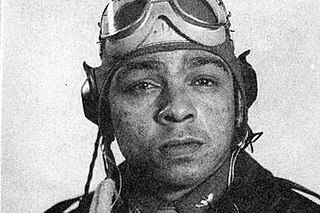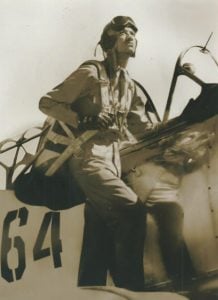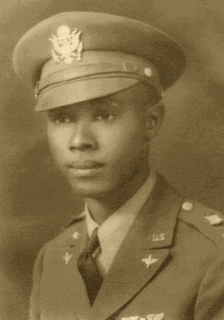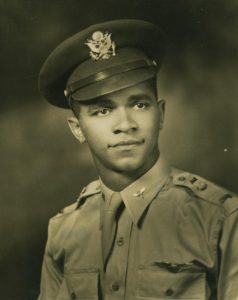The Tuskegee Airmen were a group of primarily African American military pilots and airmen who fought in World War II. They formed the 332d Expeditionary Operations Group and the 477th Bombardment Group of the United States Army Air Forces. The name also applies to the navigators, bombardiers, mechanics, instructors, crew chiefs, nurses, cooks, and other support personnel.

Lt. Col. Alexander Jefferson is an American retired Air Force officer, famous as one of the Tuskegee Airmen, the 332nd Fighter Group. He served in the United States Army Air Forces during World War II.

Lt. Col Spann Watson was a Tuskegee Airman serving in World War II. He flew over 30 missions for the famed squadron over North Africa, Italy and Southern Europe. On March 2007, Watson attended a ceremony in the U.S. Capitol rotunda, where he and other surviving veterans of the Tuskegee Airmen were honored with the Congressional Gold Medal in recognition of their service. He died on April 15, 2010, aged 93.

2nd Lt. Alfred M. Gorham (1920-2009) was a Tuskegee Airman from Waukesha, Wisconsin. He was the only Tuskegee Airman from Wisconsin, and he was a prisoner of war after his plane went down over Munich, Germany in World War II.

2nd Lieutenant Walter P. Manning was a member of the famed group of World War II-era African-Americans known as the Tuskegee Airmen. He flew 50 missions, and was awarded the Air Medal for heroism six times. After being shot down in 1945, he was captured in Austria and subsequently lynched by a mob. He was posthumously awarded the Congressional Gold Medal in 2007. Manning is the only known black man to have been lynched in Austria during World War II.

Flight Officer William Armstrong was a member of the famed group of World War II-era African-Americans known as the Tuskegee Airmen. His plane was shot down on Easter Sunday in 1945 over Austria. In 2018 he was inducted into the Rhode Island Aviation Hall of Fame.

Jerome Edwards was an American aviator who served with the Tuskegee Airmen during World War II. Edwards served in the 99th Fighter Squadron and was killed in an accident 1943 while taking off from his airbase in his P-40.

John "Ellis" Edwards was an American aviator who served with the Tuskegee Airmen during World War II. He served in the 332nd Fighter Group and earned the Distinguished Flying Cross award. He also served as a pilot in the Korean War.

2nd Lt. John H. Adams Jr. was an American member of the United States Army Air Force. He was a member of the group of World War II-era African-Americans known as the Tuskegee Airmen. He was one of the 1007 documented Tuskegee Airmen pilots.

Major William Lee Hill (Dubie) (1920-1981) from Huntington, West Virginia, was a member of the group of World War II-era African-Americans known as the Tuskegee Airmen. Hill was shot down twice during WWII, and he has been given credit for shooting down one enemy plane.
James H. Harvey III is a retired United States Army Air Corps/U.S. Air Force (USAF) officer and former African-American fighter pilot with the 332nd Fighter Group's 99th Fighter Squadron, best known as the Tuskegee Airmen, "Red Tails," or among enemy German pilots, Schwartze Vogelmenschen. He is one of the 1007 documented Tuskegee Airmen Pilots.
Harry T. Stewart Jr is a retired U.S. Army Air Force officer, a Distinguished Flying Cross recipient and a combat fighter pilots within the 332nd Fighter Group, best known as the all-African American Tuskegee Airmen.
Halbert Leo Alexander was an officer in the U.S. Army Air Force/U.S. Air Force and a fighter pilot with the prodigious, all-African American 332nd Fighter Group's 99th Fighter Squadron and 300st Fighter Squadron, colloquially known as the Tuskegee Airmen, "Red Tails," or “Schwartze Vogelmenschen” ) among enemy German pilots. He was one of the 1007 documented Tuskegee Airmen Pilots.
Woodrow Wilson Crockett(pronounced "Crow-Ket") was an officer in the U.S. Army Air Force/U.S. Air Force and a fighter pilot and interim commanding officer of the all-African American 332nd Fighter Group's 100th Fighter Squadron, best known as the Tuskegee Airmen or "Red Tails". He was one of the 1,007 documented Tuskegee Airmen Pilots.

Mac Ross was a U.S. Army Air Force officer and combat fighter pilot during World War II. A member of the Tuskegee Airmen, he commanded the 100th Fighter Squadron and served as the Group Operations Officer for the 332nd Fighter Group.

Charles DeBow was an officer in the U.S. Army Air Force and combat fighter pilot and commanding officer of the 332nd Fighter Group's 301st Fighter Squadron, best known as the prodigious, all-African American Tuskegee Airmen. He was one of the 1,007 documented Tuskegee Airmen Pilots.
Charles Blakesly "Buster" Hall was an iconic, highly decorated combat fighter pilot and U.S. Army Air Force/U.S. Air Force officer with the 332nd Fighter Group's 99th Fighter Squadron, best known as the Tuskegee Airmen or "Red Tails".
Walter Lee McCreary was an U.S. Army Air Forces/U.S. Air Force officer, former prisoner of war (POW), and one of the original combat fighter pilot with the prodigious 332nd Fighter Group's 100th Fighter Squadron, best known as the Tuskegee Airmen, "Red Tails," or “Schwartze Vogelmenschen” among enemy German pilots. He is notable for becoming one of the first hundred African American fighter pilots in history, as well as one of 1,007 documented Tuskegee Airmen Pilots.
Wilson Vashon Eagleson II, also known by the nickname Swampy, was a United States Army Air Force officer and decorated combat fighter pilot with the 332nd Fighter Group's 99th Fighter Squadron, best known as the Tuskegee Airmen. One of 1,007 documented Tuskegee Airmen Pilots, Eagleson II was credited with two confirmed enemy German aerial kills and two probable aerial kills.
Luke Joseph Weathers, Jr., was a U.S. Army Air Force officer, historic African American air traffic controller and prolific World War II combat fighter pilot with the prodigious 332nd Fighter Group's 302nd Fighter Squadron, best known as the Tuskegee Airmen, "Red Tails," or "Schwartze Vogelmenschen" among enemy German pilots. Weathers earned a Distinguished Flying Cross for defending and escorting a damaged U.S. Army Air Corps B-24 Liberator bomber against eight Messerschmitt 109s on November 16, 1944, shooting down two Me-109s.













